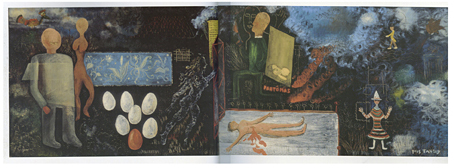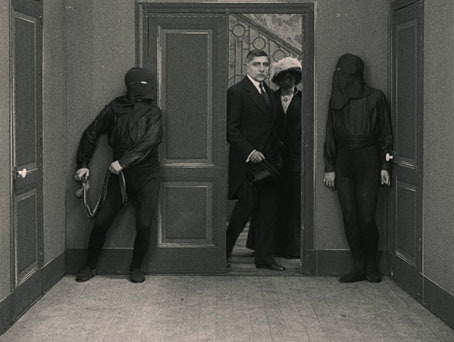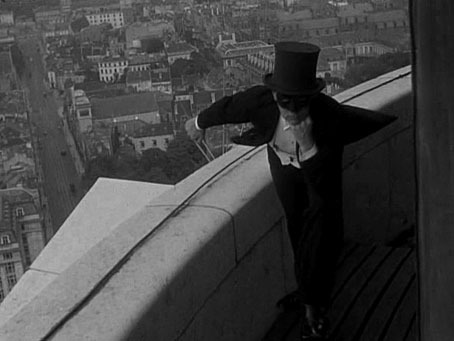John Coulthart's Blog, page 15
November 25, 2024
The Magic Shop, a film by Ian Emes

An illustration by Arthur Wallis Mills from The Strand Magazine, June, 1903.
I had not thought the place was there, to tell the truth—a modest-sized frontage in Regent Street, between the picture shop and the place where the chicks run about just out of patent incubators—but there it was sure enough. I had fancied it was down nearer the Circus, or round the corner in Oxford Street, or even in Holborn; always over the way and a little inaccessible it had been, with something of the mirage in its position…
Despite writing about an HG Wells adaptation only a week ago I hadn’t gone searching for more of them when this one turned up anyway, rather like Wells’ mysterious shop. I’d actually been looking at the filmography of the late Ian Emes, a director best known for the short animations he made for Pink Floyd’s concerts, although his career encompassed animated shorts like The Beard as well as longer films for television and the cinema. The Magic Shop, which was made in 1982, looks as though it might have been another of those shorts that used to be programmed as supporting titles for first-run features in British cinemas. Andrew Birkin’s Sredni Vashtar was one of these, a film which is also under 30 minutes in length and an adaptation of a popular piece of Edwardian fiction.
HG Wells’ story was first published in The Strand Magazine in June 1903 then collected in Wells’ Twelve Stories and a Dream a few months later. It’s been one of my favourite Wells stories since I first read it at the age of 11, as I mentioned in this review of the 1964 TV version. Wells’ fantasy reached me just as I was beginning to get very interested in conjuring tricks. I’d also been reading Victorian ghost stories in the reprint collections being published by Puffin and Lion, so a story about a shop that sold magic tricks, where the premises and proprietor had a slightly sinister quality, was exactly the kind of thing I wanted to read.
Ian Emes’ adaptation is a more successful Wells film than The Door in the Wall, and a much better adaptation of the story itself than the attempt to update the tale for The Alfred Hitchcock Hour, but Emes still doesn’t really capture the spirit of the story. The main flaw is that the actor playing the boy who wants to explore the shop is too old for the role. The narrator’s son in the story is around five or six years old, and much of the tension in the telling comes from the way that the boy sees everything that’s happening as delightful and magical while the father experiences rising alarm at the unfolding events and the situation in which the pair find themselves. The second half of the story, in which father and son are led by the shopowner into the labyrinthine warehouse behind the shop, is also lacking. Emes’ production may have been compromised by its budget but there’s no sign of the surprises that you might have expected to be filmed by a former animator. Derek Jarman regular Karl Johnson plays the father, Ron Cook is the shopowner, and there’s a cameo near the beginning from William Rushton as the man whose whining son is denied admittance to the shop. (Rushton had earlier provided the voice of the afflicted shaver in The Beard.) At the end of Emes’ film father and son find themselves teleported to what looks like a back street somewhere near the river instead of being returned to a busy London street. This reminds me that the first time I visited Regent Street myself at the age of 13 I had half a mind to go looking for the “Genuine Magic Shop”—or to try and identify the place where it might have been. The elusive nature of Wells’ establishment makes it the forerunner of the chemist shop owned by the malevolent Grail-seekers in Charles Williams’ War in Heaven, which makes me wonder now whether Williams borrowed the idea from Wells.
Ian Emes’ film may be seen at his Vimeo channel (log-in required, or you can use the Vimeo app). The story can be found in a collection of fifty-four of Wells’ short stories at Standard Ebooks, the home of free, high-quality, public-domain texts.
Previously on { feuilleton }
• The Door in the Wall, 1956
• Claude Shepperson’s First Men in the Moon
• The Beard, a film by Ian Emes
• Uncharted islands and lost souls
• Doctor Moreau book covers• The Island of Doctor Moreau
• Harry Willock book covers
• The Time Machine
• The Magic Shop by HG Wells
• HG Wells in Classics Illustrated
• The night that panicked America
• The Door in the Wall
• War of the Worlds book covers
November 23, 2024
Weekend links 753

Grow (1970) by Linda Brewer.Via.
• The week in work-related reviews: Raymond Tyler reviewed the Bumper Book of Magic at Religious Socialism, while James Palmer did the same at Foreign Policy. Meanwhile, Rob Latham at the Los Angeles Review of Books examined the legacy of the New Wave of science fiction with reviews of New Worlds 224, and The Last Dangerous Visions, Harlan Ellison’s long-delayed story collection.
• “Incline Press is a private fine press publisher in the UK, stubbornly printing with hand set, metal type on a collection of vintage machines, working with poets and artists to make limited edition books and ephemera.”
• New music: Horses In Your Blood, another dose of unhinged weirdness from Moon Wiring Club; The Source by Jon Palmer; and Ekkorääg by Tarotplane.
• At Dennis Cooper’s: Spotlight on…Rikki Ducornet The Fan-Maker’s Inquisition: A Novel of the Marquis de Sade (1999).
• At Smithsonian Magazine: “Rare atlas of astronomy from the Dutch Golden Age goes on display in England“.
• Old music: Jon Savage’s Space, a space-themed compilation on Caroline True Records.
• At The Daily Heller: Berman’s Book Boom is a boon to graphic design’s legacy.
• At Public Domain Review: Christoph Jamnitzer’s Neuw Grotteßken Buch (1610).
• Mix of the week: A Dungeon Synth mix by Flickers From The Fen for The Wire.
• At Heavy Metal Magazine: The HP Lovecraft Art of John Holmes.
• At The Quietus: The Strange World of…Laurie Anderson.
• I Can Hear The Grass Grow (1967) by The Move | Grow Fins (1972) by Captain Beefheart | The Growing (2011) by The Haxan Cloak
November 20, 2024
The Mona Lisa Curse
How I miss Robert Hughes. In print or on the television screen he was one of those rare people whose appearances you didn’t want to miss. On television especially, a medium where he excelled when discussing art or architecture. As I said when his death was announced in 2012, the first two words I wrote here (on 13th February, 2006) were “Robert Hughes”, introducing an extract from a Hughes piece that ran in The Guardian earlier that day. An impromptu choice, as was the launch date, but greeting the world with a pointer to his words felt right somehow: begin as you mean to go on.
The Mona Lisa Curse was Hughes’ last television essay, made for the UK’s Channel 4 in 2008. After I’d rewatched The Shock of the New two years ago I followed the series with a delve into as many of his films as I could find. The Mona Lisa Curse was one that I’d missed when it was broadcast, and I couldn’t find a decent copy during the retrospective binge. Happily it’s finally turned up at (yes) the Internet Archive. Hughes’ subject this time is the commodity fetishism of the art world, and the growth of money as the dominant factor in the creation, dissemination and discussion of art today. The cult of pictorial celebrity that blossomed around the Mona Lisa when it was brought to New York in 1962 is seen by Hughes as a key moment in a shift of perception that took place in the way that art was viewed in the 20th century. The pernicious effect of money on the art world had already been addressed by the chapter that Hughes added to the book editions of The Shock of the New, a piece which charted the explosive growth of the art market in the 1980s. The Mona Lisa Curse looks at all that has happened since, with American museums turned into global brands, and the ownership of art (especially anything made by a reputable artist) being seen in terms of investment as much as aesthetics.
Money has long been a factor in the production of Western art, the traditional gilded picture frame evolved because the paintings inside those frames were intended for wealthy homes. Hughes’ argument here is that the situation has never been as bad as it is today. I’ve been making similar complaints since the 1990s—whatever else they might think they’re doing, the majority of successful contemporary artists are creating exclusive objects for the ownership of the very rich—but you seldom see a complaint like this defined so well or given such a prominent platform. (Yes, unsellable art exists: land art, installations, performances, ephemeral works. Most art is still a unique object of some sort, one that can be sold and resold.) Hughes emphasises that outside the illegal drug trade, art is the largest unregulated market in the world. With billions of dollars changing hands every year nobody complicit in any part of the exchange is going to criticise the situation so long as they’re in a position to receive a portion of that money, however small.
Hughes was 70 when he made this film, although he seemed much older in his later years as a result of a near-fatal car accident in 1999. His bullish, stumbling figure is contrasted with shots of him as he was in the 1970s, including extracts from a film made shortly after he’d landed the job of art critic for TIME magazine. The clips that show him with long hair, dressed in a cut-off denim jacket, are a reminder that while in London he was friends with the other ex-pat Australians at Oz magazine. The Mona Lisa Curse, which was directed by Mandy Chang, may not have been intended as a final statement at the end of a career but it’s hard to avoid that impression when you watch it now. If Hughes’ comments about the art market seem like the curmudgeonly complaints of an old man, consider this for a moment:
With the aplomb of a banker, you’ll end up in the most hideous living-rooms in the world. The coffee-table bears the sanitized book of your work, and the magazine next to it illustrates your patron’s good taste, status and investment rule.
That was much a younger Derek Jarman, writing in 1982 when the present situation had barely begun. In the 1980s art could still make its presence felt outside the galleries even if it was only through causing some minor outrage, as with the fuss in 1989 when US politicians took exception to public money being used to exhibit works by Robert Mapplethorpe and Andres Serrano. Nobody cares today what artists do in galleries, the culture wars are being fought elsewhere. Pictorial celebrity and monetary value is all that the art world has left to capture the attention of the wider public.
I was wondering how to end this piece but the news this week has done it for me: “Magritte’s Surrealist Masterpiece Sets $121.2 Million Auction Record“. “The brand recognition of Magritte is incredibly strong,” says a New York dealer, discussing the artist as though he was a product on a supermarket shelf. Which painting will be the first to sell for a billion dollars? Place your bets now.
Previously on { feuilleton }
• Rebel Ready-Made
• The Shock of the New
• Robert Hughes, 1938–2012
November 18, 2024
The Golden Hind: A Quarterly Magazine of Art and Literature

Well, here we are at last… After years of waiting for scanned copies of The Golden Hind to turn up, now that they have done I’m still frustrated. The magazine was one of the many small arts periodicals being published in Britain during the 1920s. It had an erratic, eight-issue run from 1922 to 1924, and remains notable for being the second (and last) magazine to be co-edited by Austin Osman Spare. The artist’s first magazine venture, Form, had been edited by Spare and “Francis Marsden” (Frederick Carter), with the pair publishing two issues before the outbreak of the First World War, followed by a final issue in 1921. Spare co-edited The Golden Hind with writer Clifford Bax, creating a publication whose contents were less mystical than Form had been, while also providing more of a showcase for artists other than Spare himself.

Inevitably, it’s the artists that interest me the most in The Golden Hind, even though the magazine was running pieces by writers like Aldous Huxley and Edith Sitwell. Many of the artists have been featured here before, some of them on many occasions: Alastair (Hans Henning Voigt), John Austen, Harry Clarke, Garth Jones, Henry Keen, and Allan Odle. Spare’s own drawings have since been recycled in various books but most of the other drawings, woodcuts, linocuts and prints remain exclusive to the magazine. The John Austen contributions are especially fine, further examples of his decorated style which borrows heavily from Aubrey Beardsley and Harry Clarke, and which he used so well in his illustrated Hamlet. The spirit of Beardsley’s 1890s is very much in evidence in The Golden Hind, a demonstration, perhaps, that Spare was once again looking back to The Savoy magazine as an example to be followed; one of the essays concerns the poety of The Savoy‘s literary editor, Arthur Symons.

In addition to artists whose popular works are still reprinted today there are less well-known figures like Sidney Hunt whose drawings owed more to contemporary trends than many of the other contributors. Hunt later edited an avant-garde magazine of his own, Ray, while producing his own brand of homoerotic prints like the Ganymede with Zeus which may be seen in The Golden Hind’s final issue.

The frustration I referred to above is my usual complaint about image quality. All the copies of the magazine have been taken from microfilm archives which means the pages aren’t grey enough to be illegible but their general murkiness is enough to destroy a lot of the artwork, especially the lithographs and other prints. The samples you see here have been brightened a little which does improve some of the line art but can do nothing for the rest. But I’m not going to complain too much. It’s taken a long time to be able to browse a complete run of this magazine, and I feel fortunate to do so even in this compromised manner. Better copies may still surface eventually. Fingers crossed.











Harry Clarke’s The Devil’s Wife and her Eldest (above) isn’t named at all in the magazine, the title is the one given by Nicola Gordon Bowe in her studies of the artist. This isn’t how the picture appears in the scanned editions of the magazine either, but I’ve posted it here enough times in the past so I may as well do so again. Nicola Gordon Bowe thought that Clarke offered this drawing to The Golden Hind on the prompting of John Austen, after he’d asked Austen to assist with the Clarkes’ stained-glass business.

Previously on { feuilleton }
• The most unusual magazine ever published: Man, Myth and Magic
• A Book of Satyrs revisited
• Form and Austin Osman Spare
• More Spare things
• A Book of Satyrs by Austin Osman Spare
• Spare things
• Dreaming Out of Space: Kenneth Grant on HP Lovecraft
• MMM in IT
• Abrahadabra
• Murmur Become Ceaseless and Myriad
• New Austin Spare grimoires
• Austin Spare absinthe
• Austin Spare’s Behind the Veil
• Austin Osman Spare
November 16, 2024
Weekend links 752
Captain Nemo by Alphonse de Neuville, from Twenty Thousand Leagues Under the Seas (1875) by Jules Verne.
• “…physical remoteness is a category of its own. It is an enhancer: It can make the glorious better and the terrible worse. The oceanic pole of inaccessibility distills physical remoteness on our planet into a pure and absolute form. […] Point Nemo is nearly impossible to get to and offers nothing when you arrive, not even a place to stand. It is the anti-Everest: It beckons because nothing is there.” Cullen Murphy explores the remotest place on Earth. A long and fascinating read, but no mention of Point Nemo’s dreaming tenant.
• More Bumper Book business: Smoky Man has posted the second part of his analysis of the book for (Quasi) (in Italian) which includes some comments from myself about the origin of the Moon and Serpent Magical Alphabet, and why the letter Q in the alphabet is assigned to Cthulhu. Elsewhere, Panini have announced an Italian edition of the Bumper Book for May next year, while at The Beat Steve Baxi reviewed the book from a philosophical perspective.
• At the BFI: David Parkinson on where to begin with Louis Feuillade. I’d suggest starting with Fantômas rather than Les Vampires but then I’m biased.
The combination of magic(k)al, ceremonial action, vivid colour and paradoxically serious camp in Jarman’s Super 8 films of the ’70s bears the influence of Kenneth Anger, but the differences between Jarman’s sensibility and Anger’s are more striking than the resemblances. Jarman’s vision is more materialist, austere and hermetic, and less sociological; where Anger identifies the glamour of American popular culture with the Will of the Crowleyan magician, Jarman situates the discovery of the cinematographic mechanism imaginatively within the history of alchemy. Anger cast rock stars as gods and adepts with the intention of harnessing the energy of their recognition; Jarman casts Fire Island, then in its heyday as a gay resort, as a desert defined by sculptural details and occupied by a single masked figure, in scenes that both recall his landscape paintings of the ’60s and ’70s and anticipate the design of his garden at Dungeness.
Luke Aspell on Derek Jarman’s hermetic film/painting, In the Shadow of the Sun
• At Smithsonian Magazine: “Visions of nuclear-powered cars captivated Cold War America, but the technology never really worked”.
• At The Spectator podcast: host Sam Leith talks to Michael Moorcock about 60 years of New Worlds magazine.
• At Public Domain Review: “Light from the Darkness” — Paul Nash’s Genesis (1924).
• At Bandcamp: “Disco godfather Cerrone’s enduring influence on dance music”.
• At Unquiet Things: The Art of Survival: Eyeball Fodder in Dark Times.
• Mix of the week: DreamScenes – November 2024 at Ambientblog.
• New music: The Laugh Is In The Eyes by Julia Holter.
• At The Daily Heller: The College of Collage.
• RIP jazz drummer Roy Haynes.
• Thermonuclear Sweat (1980) by Defunkt | Nuclear Drive (1982) by Hawkwind | Nuclear Substation (2005) by The Advisory Circle
November 13, 2024
The Door in the Wall, 1956
The Door in the Wall is one of HG Wells’ most popular short stories, a fable-like piece which has slipped across the genre barriers into collections as diverse as Tales of the Unexpected (1924), More Ghosts and Marvels: A Selection of Uncanny Tales (1927), The World’s Great Mystery Stories (1943), The Dream Adventure (1963), Magazine of Horror (1965), The Sixth Fontana Book of Great Ghost Stories (1970), Tales of the Occult (1975), Black Water: The Anthology of Fantastic Literature (1983), Classic Science Fiction Stories (2022), and many others. The categorisations are more an attempt to fill out a contents list with quality material than a reflection of the story itself. Most readers would regard The Door in the Wall as a straightforward work of fantasy, in which a small boy discovers a door in a wall in a very ordinary London street, a portal which leads him into a paradisiacal garden. When the boy grows into man he remains haunted and eventually tormented by his memories of the enchanted world he found beyond the door.
Given the popularity of the story and its simple narrative you’d expect there to be more film adaptations than there are. This short from 1956 (links below) was the only directorial effort by Glenn H. Alvey, and a very odd film it is. What might have been a worthy if uninspired transcription of Wells’ tale is here confounded by Alvey’s “Dynamic Frame”, a trademarked invention which involved filming the whole thing in VistaVision then masking portions of the frame with a matte that continually changes the aspect ratio of the picture to suit the action, even following the actors around the screen. Adjusting the aspect ratio while the film is running isn’t an uncommon technique but Alvey’s process is a distinctly obtrusive one, which no doubt explains why it wasn’t further developed elsewhere. As for the adaptation, the enchanted garden beyond the door turns out to be nothing more than a large and very typical English country estate, with a few parrots and a pair of caged budgerigars providing some exotic flavour. (Now that London has wild parakeets roosting in its trees even these details are no longer exotic.) Wells’ garden is a numinous and magical place, one that might have been better represented with a change from black-and-white to colour, as when Dorothy opens the door to Oz. Alvey’s adaptation is worth watching more for its views of ungentrified post-war London streets than it is for the drama. It also features an unusually restrained musical score by James Bernard, a composer better known for the thundering soundtracks he provided for many Hammer horror films. Bernard aside, HG Wells’ stories deserve better treatment than this.
• The Door in the Wall: part one | part two
Previously on { feuilleton }
• Claude Shepperson’s First Men in the Moon
• Uncharted islands and lost souls
• Doctor Moreau book covers
• The Island of Doctor Moreau
• Harry Willock book covers
• The Time Machine
• The Magic Shop by HG Wells
• HG Wells in Classics Illustrated
• The night that panicked America
• The Door in the Wall
• War of the Worlds book covers
November 11, 2024
Enfantômastic!
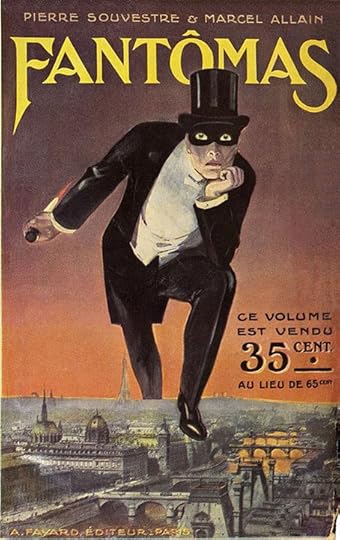
Uncredited cover art for the first publication, 1911.
The post title is a word apparently invented by James Joyce, one whose origin I’ve yet to discover. There may be some slight disparagement in its use of “enfant”, a suggestion that the Fantômas novels (or the films derived from them) were childish pleasures. If so, those childish pleasures had many supporters among the cultural avant-garde of Paris, as we’ll see below.
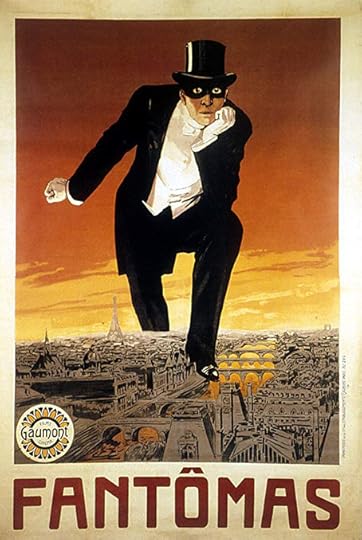
Uncredited poster art, 1913. The blood-stained dagger on the cover of the novel was too much for Gaumont.
This isn’t the first time I’ve written about Fantômas, the master criminal whose exploits thrilled French readers in the years before the First World War. But I’m writing now having finally read a translation of Marcel Allain and Pierre Souvestre’s first Fantômas novel, and also watched the five Louis Feuillade films which introduced Fantômas to an international audience in 1913 and 1914. The novel was worth reading even though it doesn’t rise much above the pulp fiction of the time; Allain and Souvestre were writing in haste, their books were never going to win any literary awards. Fiction doesn’t have to be finely-crafted in order to capture the popular imagination (look at James Bond…), but Fantômas is unusual for being so popular while also being essentially formless: a persistently elusive criminal mastermind with no substantiated identity that the police can discover, whose prowess with disguise enables him to infiltrate French society at all levels. Criminal masterminds are plentiful in English literature but they’re usually hiding in the background of stories with heroes as the central character, as with Professor Moriarty and Sherlock Holmes. Guy Boothby’s Doctor Nikola has Fantômas-like qualities but he’s a more ambivalent character, less of an outright villain. A closer English comparison might be Fu Manchu whose first appearance in print was in 1912, a year after the literary debut of Fantômas. The rivalry between Fu Manchu and Denis Nayland Smith of Scotland Yard matches the tireless pursuit of Fantômas by Inspector Juve of the Sûreté; yet Fu Manchu still has a personal history and, in the later novels, motivations beyond mere criminality. Nothing is known of Fantômas outside his criminal endeavours. His character is so nebulous that one of the later stories sees Inspector Juve arrested after his superiors have convinced themselves that he must be the real hand behind the Fantômas crimes.
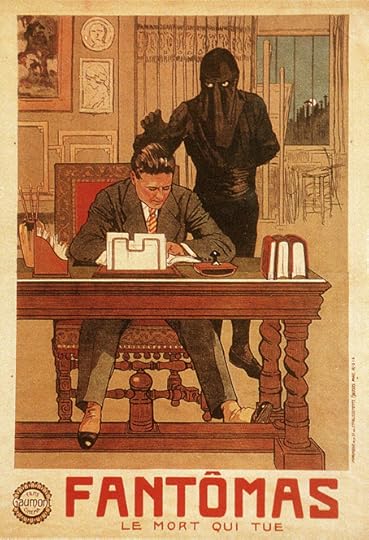
Uncredited poster art, 1913. Fantômas is about to turn his unwitting victim into “The Corpse that Kills”.
On an artistic level the Feuillade adaptations are much more satisfying than their source, even though Fantômas in the films isn’t as triumphantly murderous as he is in the books. After years of only knowing the adaptations from blurred and washed-out stills it’s been a revelation to see the recent Gaumont restorations which have been mastered from the best available prints, cleaned of scratches and other flaws, and projected at the proper speed. The Feuillade serials have circulated for years in inferior copies but I’d always held off watching them in the hopes that better prints might arrive. I’m glad I waited. Cinema was still a young medium in 1913 but Feuillade was a good director, skilled at creating suspense and engineering sudden surprises. He was also working with a decent troupe of actors, especially René Navarre as the villainous leading man. The misconception that early silent acting is all grandiose gestures and exaggerated facial expressions is dispelled in films like these where the acting is generally restrained even when the subject matter is lurid and melodramatic.
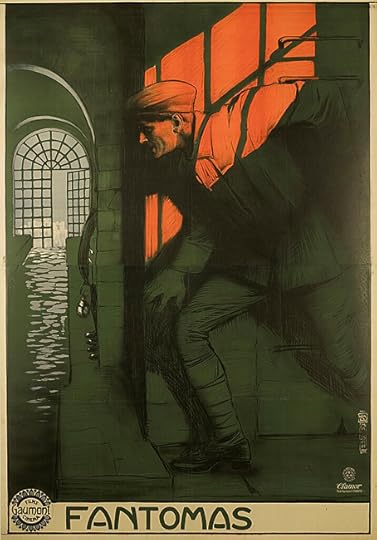
Poster art by Achille Mauzan, 1913.
The UK release of the Feuillade films by Eureka happens to arrive just after 100th anniversary of the first Surrealist Manifesto, a coincidence, no doubt, but a fitting one. The Surrealists enjoyed the “waking dream” quality of the cinema experience, and were especially besotted with Feuillade’s Fantômas serials:
Over the next two decades, Fantômas was championed by the Parisian avant-garde, first by the young poets gathered around Guillaume Apollinaire, who, together with Max Jacob, founded a Société des Amis de Fantômas in 1913, and later by the Surrealists. In July 1914, in the literary review Mercure de France, Apollinaire declared the imaginary richness of Fantômas unparalleled. The same month, in Apollinaire’s own review, Les Soirees de Paris, Maurice Raynal proclaimed Feuillade’s Fantômas saturated with genius. Over the next two decades, poets such as Blaise Cendrars (who called the series “The Aeneid of Modern Times”), Max Jacob, Jean Cocteau, and Robert Desnos, and painters such as Juan Gris, Yves Tanguy, and René Magritte, incorporated Fantômas motifs into their works. Pierre Prévert’s 1928 film, Paris la Belle, featured a Fantômas book cover in the closing sequence, and the Lord of Terror was adapted to the Surrealist screen in Ernest Moerman’s 1936 film short, Mr. Fantômas, Chapitre 280,000. As the century progressed, Fantômas remained a minor source of artistic inspiration as the subject of cultural nostalgia.
Robin Walz from Serial Killings: Fantômas, Feuillade, and the Mass-Culture Genealogy of Surrealism (1996)
All of which has had me searching for examples of the above, some of which I hadn’t seen before. Fantômas was a recurrent source of inspiration for René Magritte yet “the Lord of Terror” is often reduced to a footnote in discussions of Magritte’s career. The appropriation of the name of Fantômas, along with motifs from the novels and films, is a unique moment in art history, one that points the way to the further appropriations of Pop Art and the cultural free-for-all we see in the art world today.
Fantômas (1915) by Juan Gris
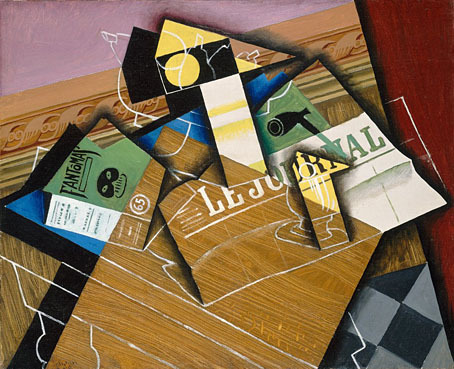
Fantômas (1918) by Josef Capek
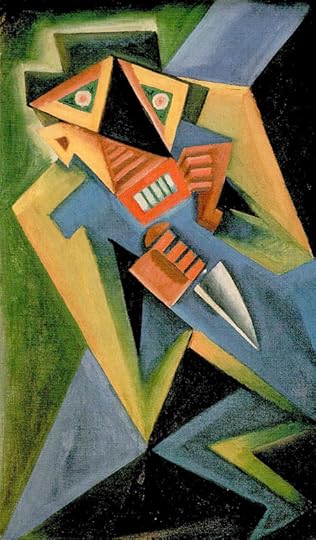
Fantômas (1925) by Yves Tanguy
Yves Tanguy had only been painting for a couple of years when he was producing pictures like this one. The vague landscapes populated by unidentified objects and organisms didn’t emerge until later.
The Menaced Assassin (1926) by René Magritte
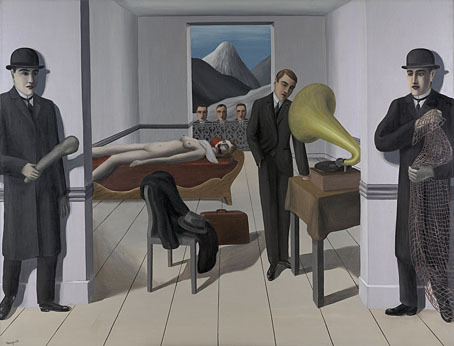
The shot from Fantômas that you see reproduced most often in art books is this one which Magritte remembered when he was painting The Menaced Assassin. The painting isn’t a duplicate but it’s certainly Fantômas-like in its accumulation of suspense, voyeurism, potential ambush, and the aftermath of a violent crime.
Fantômas (1927) by René Magritte
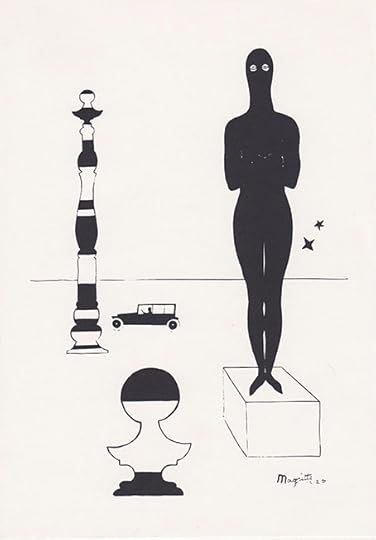
Fantômas appeared on the first book covers and film posters masked while wearing evening dress, but in the films when he’s not heavily disguised he’s more likely to appear as what the intertitles describe as “the Man in Black”, creeping around in a leotard with his head covered like a medieval executioner. His accomplices do the same, and similar outfits may be seen in Feuillade’s follow-up to Fantômas, Les Vampires. Magritte made use of these sinister silhouettes in several drawings and paintings of the 1920s.
The Man from the Sea (1927) by René Magritte
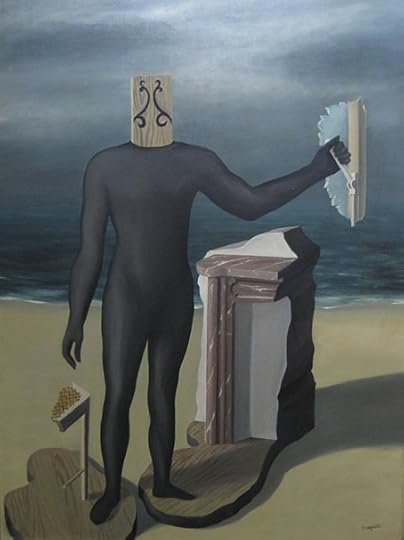
The Female Thief (1927) by René Magritte
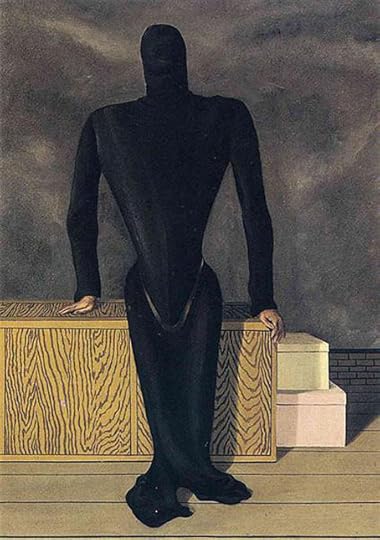
La Femme 100 têtes (1929) by Max Ernst
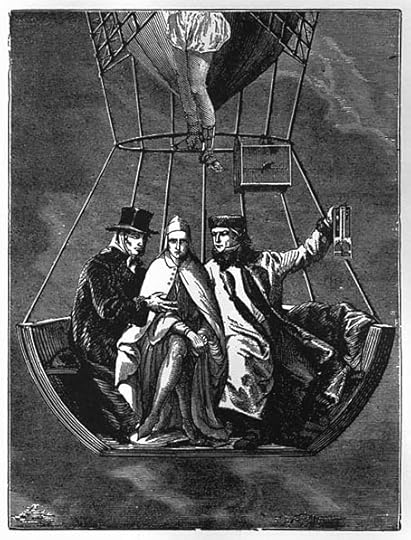
This plate from Max Ernst’s first collage novel bears the title “Fantômas, Dante and Jules Verne”. André Breton also refers to the illustrators of Fantômas in the introduction to the book. (Thanks to Vincent for the reminder!)
Fantomas: Mrtvý, Jenž Zabíjí (1929)
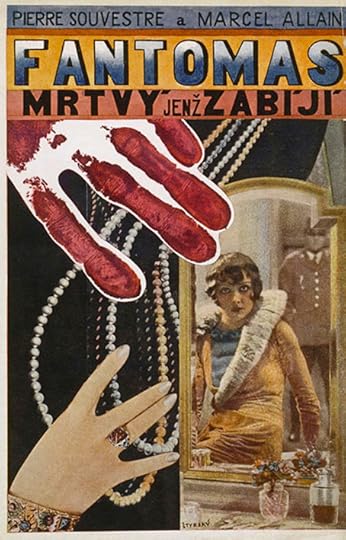
Cover art by Jindrich Styrsky for a Czech translation. Styrsky was one of the first Czech Surrealists.
Monsieur Fantômas (1936)
A short “Film Surrealiste” made by Ernest Moerman in which Jean Michel (Fantômas) and Trudi Van Tonderen (Elvire) enact a series of dramatic scenes, most of which are filmed on a Belgian beach with a handful of props.
René Magritte and The Barbarian
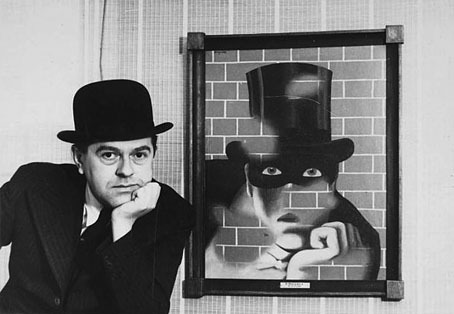
One of the more well-known photo portraits of Magritte, taken in London in 1938. I used to wonder why you seldom saw reproductions of The Barbarian (1927) on its own. The painting was one of many artworks destroyed by fire or bombing during the Second World War.
The Flame Rekindled (1943) by René Magritte
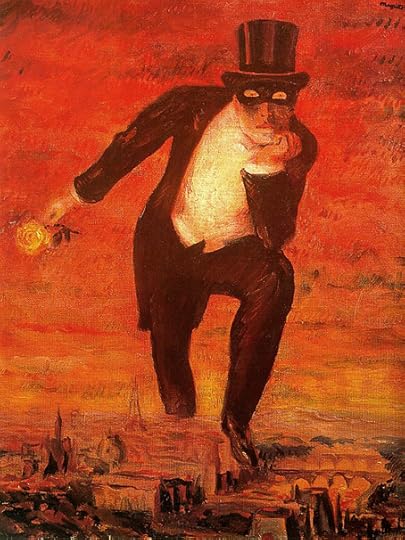
And the loss of Magritte’s painting may explain the title of this later one. Or maybe this refers to the artist rekindling his earlier Fantômastic enthusiasms.
Ballad of Fantômas (1942) by Robert Desnos
A poem performed as a radio broadcast with musical accompaniment.
Écoutez, … Faites silence
La triste énumération
De tous les forfaits sans nom,
Des tortures, des violences
Toujours impunis, hélas!
Du criminel Fantômas…
Continues here with rhyming English translation by Timothy Ades.
Elsewhere on { feuilleton }
• The Surrealism archive
Previously on { feuilleton }
• Bugs Bunny meets Fantômas in the Aquarium of Love
• The Dark Ledger
November 9, 2024
Weekend links 751
The Treasures of Satan (1895) by Jean Delville.
• Among the new titles at Standard Ebooks, the home of free, high-quality, public-domain texts: Là-Bas, the celebrated account of Satanism in fin-de-siècle France by Joris-Karl Huysmans.
• New music: Chronicle by ARC, and The Invisible Road: Original Recordings, 1985–1990 by Sussan Deyhim & Richard Horowitz (linked here before but that was for the pre-release).
• Fabulous Animals (1975), a six-part British TV series about cryptozoology presented by David Attenborough (!).
• At Colossal: “Colour and repetition form optical rhythms in Daniel Mullen’s geometric paintings“.
• At Public Domain Review: Anton Seder’s The Animal in Decorative Art (1896) turns up again.
• Unseen scenes from Sergei Parajanov’s The Colour of Pomegranates.
• Steven Heller’s font of the month is Roadhouse.
• Fanzine covers selected by DJ Food.
• Mark Webber’s favourite records.
• Satan Side (1972) by Keith Hudson | Satan Is Boring (1986) by Sonic Youth | Sataan Is Real (1991) by Terminal Cheesecake
November 6, 2024
November shirts
Skull Print shirts.
November weather isn’t exactly suitable for T-shirt wearing when you live this far north (although it’s unseasonably mild just now) but I’ve recently added four more shirt designs to my Skull Print page. As I was saying last month, now that I’ve quit CafePress all shirts featuring my art and design will be done through Skull Print, a small business who specialise in shirt-printing, and do so with very reasonable prices: £22 (inc. postage) for the UK, £32 (inc. postage) for the rest of the world. Long sleeves, sizes 3XL and over, and tie-dye colours add a little more to the cost.
It’s always the case when creating spin-off products that I’m guessing what people may want. Three of the four new designs have been extracted from popular works of the past (the Tarot designs have been given a boost now that they’re featured in the Bumper Book of Magic). I’m always open to suggestions for new designs so long as they don’t infringe on any trademarks or copyright agreements.
The Chaos symbol is a new creation based on a shirt I designed for Hawkwind’s Chronicle Of The Black Sword tour in 1985 (see this post). The symbol isn’t exclusive to Hawkwind, of course. Michael Moorcock invented it for the original Elric stories in the 1960s after which it was picked up by the practitioners of Chaos magic in the 1980s.
And this is one of my popular Alice in Wonderland designs which I amended for The Graphic Canon in 2012, extending the square composition into a rectangle. I may add one or two more from this series in future although this was one was easier to adapt than some of the others.
November 4, 2024
Intégrale Howard Phillips Lovecraft
More Lovecraft book covers. Blame the season for this although depictions of Lovecraft’s cosmos have been occupying my thoughts for a while now, as I explain below.
A couple of years ago I wrote about the weird-fiction collections that Mnémos had been publishing in France, all of which used for their cover art paintings by the Polish “anti-symbolist” Zdzislaw Beksinski. I like Beksinski’s paintings very much, and thought they were a good match for most of the covers that Mnémos had produced, being sufficiently weird and evocative without being directly illustrative. (The sole exception was the peculiar dog-like creature on the cover of a Frank Belknap Long collection, The Hounds of Tindalos. Long’s “hounds” are malevolent extra-dimensional entities whose name shouldn’t be taken literally.) I mentioned that Mnémos had also announced a seven-volume collection of HP Lovecraft’s fiction and non-fiction, but at the time of writing there were no pictures of the books available, and I’d forgotten all about the collection until a few days ago. All the books in the set, which are translated by David Camus, have since been reprinted as standalone volumes.

Intégrale Howard Phillips Lovecraft is a little deceptive as a title for a Lovecraft collection when the word “intégrale” is often applied to complete editions of something. The Mnémos set looks like it contains all of the fiction in the first few volumes plus a quantity of essays, but Lovecraft famously wrote more letters than he did stories; the letters here are a small selection inside volume 6. In addition to the books, the collection also contains a map of the Dreamlands, together with cards and bookmarks embellished with details from Beksinski’s paintings.

As with the Mnémos covers for Frank Belknap Long and Clark Ashton Smith, you could use many different Beksinski paintings for these editions, all of which would work to some degree. Even if some of them seem mismatched they offer a change of direction away from those varieties of fantasy art which have become very mannered in recent years when applied to weird fiction in general and Lovecraft’s stories in particular. This is partly a result of over-production: the huge success of the Call of Cthulhu role-playing game drove a demand for more and more Lovecraftian artwork, with the result that clichés emerged sooner than they would have done if the available imagery was limited to book illustrations and comic strips. I’ve contributed to the situation as much as most although I’ve also kept trying to find directions away from the stereotypes; my Cthulhoid picture was one such attempt even it still leans on the tentacular. I’ve been thinking recently of following the King in Yellow portrait with more poster-size art that explores other possibilities in this area. I’d encourage other artists to do the same when they can (commercial constraints often force your hand). Beksinski’s paintings show one route out of the mannerist cul-de-sac.





Elsewhere on { feuilleton }
• The book covers archive
• The fantastic art archive
• The Lovecraft archive
Previously on { feuilleton }
• Beksinski on film
• Beksinski at Mnémos
John Coulthart's Blog
- John Coulthart's profile
- 31 followers












